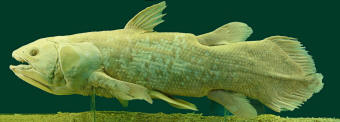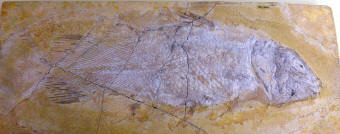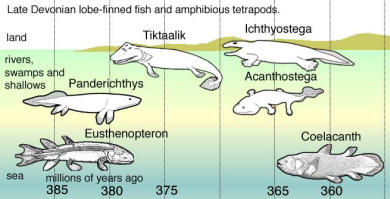Overview
The first
fish and the first vertebrates, were the
ostracoderms, which
appeared in the Cambrian Period, about
510 million years ago, and became extinct
near the end of the Devonian, about 377
million years ago. Ostracoderms were jawless fishes found mainly in fresh
water. They were covered with a bony armor
or scales and were often less than 30 cm (1 ft) long. The ostracoderms are
placed in the class
Agnatha along with the
living jawless fishes, the
lampreys
and
hagfishes, which are
believed to be descended from the ostracoderms, as are all jawed fishes, or
gnathostomes. Paired
fins, or limbs, first evolved within this group.
The
placoderms, a group of jawed fishes,
appeared by the beginning of the
Devonian,
|
The Late Devonian was home to many species of lobe-finned fish like Eusthenopteron, Panderichthys, Tiktaalik and the first tetrapods, such as Acanthostega whose limbs had eight digits, and Ichthyostega which had seven. Other lobe-finned fishes common in the Paleozoic include the Coelacanths, which survive to this day. (Picture Source) |
The acanthodians, or spiny sharks, appeared by the late Silurian, about 420 million years ago, and became extinct before the end of the Permian, about 250 million years ago. However, scales and teeth attributed to this group, as well as more derived gnathostomes such as Chondrichthyes and Osteichthyes date from the Ordovician (~460 million years ago). Acanthodians were generally small sharklike fishes varying from toothless filter-feeders to toothed predators. They were once often classified as an order of the class Placodermi, another group of primitive fishes, but recent authorities tend to place the acanthodians nearer to or within the living gnathostomes.
Cartilaginous fishes, class Chondrichthyes, consisting of sharks, rays and chimaeras, appeared by about 395 million years ago in the middle Devonian. The modern bony fishes, class Osteichthyes, appeared in the late Silurian or early Devonian, about 416 million years ago. Both the Osteichthyes and Chondrichthyes may have arisen from either the acanthodians or placodermi. A subclass of the Osteichthyes, the ray-finned fishes (Actinopterygii), have became the dominant group of fishes in the post-Paleozoic and modern world, with some 30,000 living species. However, another subclass of Osteichthyes, the Sarcopterygii, including lobe-finned fishes including coelacanths and lungfish) and tetrapods, were the most diverse group of bony fishes in the Devonian. Sarcopterygians are basally characterized by internal nostrils, lobe fins containing a robust internal skeleton, and cosmoid scales.
Coelacanth
 |
| Specimen of Latimeria chalumnae in the Natural History Museum, Vienna, Austria (length: 170 cm - weight: 60 kg). This specimen was caught on 18 October 1974, next to Salimani/Selimani (Grand Comoro, Comoro Islands (Picture Source) |
 |
|
Coelacanth species Undina penicillata, Upper Jurassic, Germany (Picture Source) |
Coelacanth is the common name for an order of fish that includes the oldest living lineage of Sarcopterygii (lobe-finned fish + tetrapods) known to date.
Discovery
The coelacanths, which are related to lungfishes and tetrapods, were believed to have been extinct since the end of the Cretaceous period. The coelacanth is actually more related to tetrapods than the ray-finned fish. They were considered the "missing link" between the fish and the tetrapods until the first Latimeria specimen was found off the east coast of South Africa, off the Chalumna River in 1938. They are, therefore, a Lazarus taxon. Since 1938, Latimeria chalumnae have been found in the Comoros, Kenya, Tanzania, Mozambique, Madagascar, and in iSimangaliso Wetland Park, Kwazulu-Natal in South Africa. The second extant species, L. menadoensis, was described from Sulawesi, Indonesia in 1999 by Pouyaud et al. based on a specimen discovered by Erdmann in 1998 and deposited in Indonesian Institute of Sciences (LIPI). The first specimen of this species was only photographed at a local market by Arnaz and Mark Erdmann before being bought by a shopper. The coelacanth has no real commercial value, apart from being coveted by museums and private collectors. As a food fish the coelacanth is almost worthless as its tissues exude oils even when dead, imparting the flesh with a foul flavor.
They first appeared in the fossil record in the Middle Devonian. Prehistoric species of coelacanth lived in many bodies of water in Late Paleozoic and Mesozoic times.
Coelacanths are lobe-finned fish with the pectoral and anal fins on fleshy stalks supported by bones, and the tail or caudal fin diphycercal (divided into three lobes), the middle one of which also includes a continuation of the notochord. Coelacanths have modified cosmoid scales, which are thinner than true cosmoid scales. Coelacanths also have a special electroreceptive device called a rostral organ in the front of the skull, which probably helps in prey detection. The small device also could help the balance of the fish, as electrolocation could be a factor in the way this fish moves.
Although now represented by only two known living species, as a group the coelacanths were once very successful with many genera and species that left an abundant fossil record from the Devonian to the end of the Cretaceous period, at which point they apparently suffered a nearly complete extinction. Before the living specimens were discovered, it was believed by some that the coelacanth was a "missing link" between the fish and the tetrapods. It is often claimed that the coelacanth has remained unchanged for millions of years, but, in fact, the living species and even genus are unknown from the fossil record. The most likely reason for the gap is the taxon having become extinct in shallow waters. Deep-water fossils are only rarely lifted to levels where paleontologists can recover them, making most deep-water taxa disappear from the fossil record.
"Living Fossil"
Some species which appear in the fossil record are still alive today. These are commonly referred to as living fossils. Young earth creationists (YEC) often refer to living fossils as evidence for a young earth. The reasoning is that since all organisms were alive only 4,300 years ago, (just before Noah's Flood), then it is reasonable to assume that they are still alive today. The presence of a living fossil in no way is evidence for a young earth. Yes, there are fossil lifeforms that are thought to be extinct, which occasionally turn up as living organisms, but there are millions more which are long gone, that went extinct millions of years ago, and there is no evidence they are alive today. Therefore, we have millions of extinct species, and a handful of so-called "living fossils." The evidence strongly supports millions of years of extinction, and an old earth.
End of Reading
Return to the Old Earth Ministries Online Earth History Curriculum homepage.
![]()
Source: Prehistoric Fish
